c3controls IEC Terminal Block configurations available in both screw clamp and spring clamp connections from 5mm to 25mm with ratings from 20A to 232A.
Introduction
By 2022, fixed automation is expected to reach $120 billion US dollars. In the world of factory automation, there has been a continued effort to operate multiple processes in a controlled manner.
Mass production is therefore helped by increasing production quality and reducing time. Having the proper electronic equipment located in the control cabinet is crucial.
Terminal blocks are a vital part of the process. They help to implement signal distribution and safe energy and it’s important to know more about how they work and when to use them.
Keep reading to learn everything you need to know about the wire terminal block.
What Terminal Blocks Are
A terminal block is a modular, insulated block that secures two or more wires together. Factories use terminal blocks to secure and/or terminate wires.
In their most basic form, terminal blocks consist of several individual terminals which are arranged in a long strip. The terminal block is most useful for connecting wiring to ground.
There are hundreds of millions of terminal blocks in use today, with more being installed every day.
Advantages of Terminal Blocks
The biggest advantage of terminal blocks is the cost. They’re cheaper compared to other types of connectors.
Terminal blocks also can be a time saver as the process to connect wires isn’t as elaborate as some others are. Most well-equipped shops can connect wires using a terminal block easily just by stripping them.
Flexibility and Ease of Modification
Flexibility is among the primary benefits of terminal blocks. They allow easy addition or removal of wires, meaning they are best for installations where constant alterations and adjustments are required. Neat and organized wiring will allow for easy identification. This will make any kind of changes easy and less cumbersome during troubleshooting to ensure that adjustments are done fast enough without much hassle.
Reduce Space
By investing in multi-level terminal blocks you can reduce panel space by up to 50%. That’s because the multi-level blocks contain multiple levels of circuits with that single block.
Increase Safety
Terminal blocks increase safety by grounding, isolating, and protecting the other components in the electrical circuit. Terminal blocks are available with finger-safe connections to prevent electrical shock.
And, terminal blocks can also provide test points, which add even more safety to the circuit.
Easy Installation
They can then be installed using a screwdriver. They also ensure fast connection/disconnection which helps with both maintenance and troubleshooting.
With electrical power, the electrical terminal block is used to connect electrical switches and outlets to the mains.
Made of Copper Alloy
Most terminal bodies consist of a copper alloy that uses the same expansion coefficient as the wire intended for use. Using the same expansion coefficient helps prevent loosening due to differing expansion rates.
It also reduces corrosion which is caused by electrolytic action between two different metals.
Disadvantages of Terminal Blocks
The biggest disadvantage of terminal blocks is that wires can be knocked loose from them if vibration or jostling happens. Even well-secured connections are vulnerable to being knocked loose.
Always test connections prior to implementing it. Make sure it can withstand the conditions it’s being put to.
Terminal blocks are also sometimes too large for the areas where they’re needed. They often make better options where in-cab and non-essential wiring is used.
Types of Terminal Block Structures
Terminal blocks can be classified both according to their structure and their device type.
Device Types
Terminal blocks can be grouped by the type of device they connect or by the application.
1. Disconnect Blocks
A disconnect terminal block is designed to provide electrical connections that allow for the easy breaking and connecting of circuits. These blocks are designed with a lever, switch, or similar mechanism by which users can break or reconnect the circuit without unscrewing the wires. This function makes them specifically handy in applications where numerous maintenance, testing, or alterations are necessary.
The industrial control panel, equipment, and automation system are perhaps the most common fields of application for disconnect terminal blocks. Their use enhances safety when fast circuit isolation is required and, therefore, minimizes the chance of electrical shock and accidental shorting during troubleshooting. In addition, these blocks make the task of locating and isolating faults in a complex electrical system much easier.
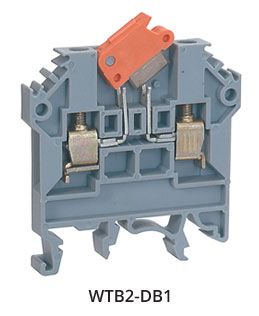
2. Fuse Terminal Block
It is a terminal block that has a fuse built directly into it to protect the circuits. This installation does not need any other overcurrent protection device outside because it has been simply wired. In plain language, the fuse is being installed in a series connection between the input and output wires; hence, continuity is directly provided.
Whenever there is a fault, the fuse will blow out in order to block current and protect the electrical system from damage. The majority of the modern fuse terminal blocks have an LED indicator, which lights up in case of a fuse failure. It makes the process of troubleshooting very easy because it provides a clear visual on the state of the fuse.
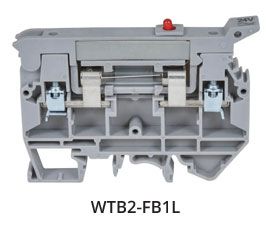
3. Ground Terminal Block
A ground terminal block is one of the important electrical connectors that directly connect wires to the ground, providing an effective and secure ground connection. Although it looks very similar to a standard screw-in terminal block, the primary function of this device is to transfer the electrical current passing through the wire to the point of grounding. This could be integrated into the panel itself, rail-mounted, or surface-mounted. Ground terminal blocks are necessary to ensure electrical safety and reliability via a secure ground connection.
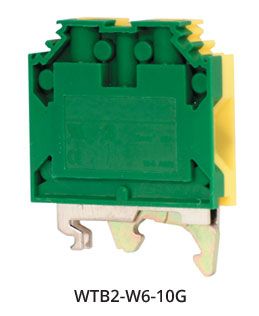
4. I/O Terminal Block
An I/O terminal block is an electrical connector that interfaces numerous input and output devices with a controller, a device like a programmable logic controller (PLC), or any other automation system. Such terminal blocks provide a point to bring together several wires from sensors, actuators, switches, and other field devices so that they can be organized and distributed in a neat way to the control system.
5. Power Distribution Block
A Power Distribution Terminal Block is an essential part of electrical systems that helps distribute power from one main source to several circuits or devices. It makes wiring simpler by providing a single point where multiple connections can be safely made, ensuring electricity flows properly through different parts of a system. This type of terminal block is commonly used in industrial, commercial, and residential settings to keep electrical connections organized and protected.
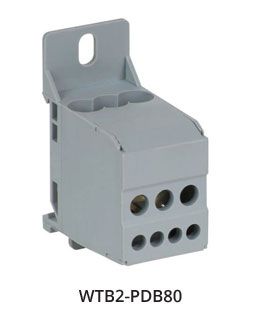
6. Sensor/Actuator Terminal Block
A sensor/actuator terminal block is one designed to establish a connection between a control system and sensors or actuators. These may include programmable logic controllers or other automation devices. With these terminal blocks, there can be organized and efficient input signals from sensors and output signals to actuators wiring within industrial and commercial automation systems.
7. Thermocouple Terminal Block
A thermocouple terminal block is the sort of a block made for the secure connection of thermocouple lead wires without creating undesired electrical contact. The difference from the standard terminal block is that if different metals touch and create an unwanted junction or voltage, the created voltage will be minimized. It avoids it by clamping the thermocouple leads on either side of the block, therefore maintaining a secure and reliable join. In some terminal blocks of thermocouples, an internal metal strip is used; that strip is made of the same material used for the wire of the thermocouple. It ensures minimal chances of new junction creation and assists in very accurate temperature measurement.
8. Tab Connector Terminal Block
This is another type of electrical connector and commonly used for the joining of wires. It consists of a wire, secured at one end of a connection, which can be easily inserted onto a tab. The wire, based on the connector type, can be crimped or soldered with a means of securing it in place for a good connection. These terminal blocks come with different configuration forms. Most common is one side with a tab connection for easy attachment of wires and the other side with a screw clamp connection, to allow flexibilities in different electrical installations. This dual-connecting method renders both dependable and versatile means of fixing several wiring needs.
9. IDC (Insulation Displacement Connector) Terminal Block
An insulation displacement connector terminal block is a special connector that was first designed for the telecommunications industry. Its purpose is to terminate wires without removing the insulating material. The IDC has sharp blades inside, designed to slice through the insulation and engage directly on the wire itself. Initially, it best fit solid wires, but it has been developed in such a way that it now works with both solid and stranded wires. This makes IDCs versatile, providing an assured connection for electrical needs to be connected quickly and safely, without the extra preparation that traditional connectors quite often need.
10. Spring-cage/Spring-loaded Terminal Block
This is another popular choice in wire connections, mainly because these terminal blocks are very reliable and easy to work with. They use a spring mechanism to hold the wires securely in place. A wire is connected by just inserting it into the terminal block, and if a more secure connection is required, a ferrule can be used. A spring release tool holds the wire or ferrule tightly and is released to connect wires; this may be a special tool or a little screwdriver. It is in these features that make these terminal blocks highly appreciated for safe and contact-maintaining connections, making them most preferred in various applications.
11. Barrier Terminal Block
The barrier terminal block, also known as the Europe connector, is a type of terminal block secured with screws to hold wires. It finds wide use in many applications and is therefore vital for providing reliable electrical connections. The screw clamps the wire; it's down after stripping to the right length. A more firm and secure connection, then, is achieved—a fundamental link to the safety and performance of the system. Other functions of some barrier terminal blocks include a protective lid for safeguarding the wiring from being exposed to the environment or for protection against accidental touch. In essence, they are robust in connecting wires, both industrially and at home, in electrical systems.
Structure Types
1. Single Feed Through
The most basic type of terminal block is single feed products. These are used for wire-to-wire
connection.
Single feed terminal blocks have one output and one input contact. The two separate wires are fed into either side of the terminal block. Then they’re connected within its housing.
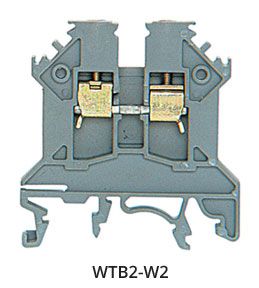
2. Dual Level
Dual level terminal blocks use two levels of contacts. This helps simplify wiring and save space.
Often, multi-level products use a bridge to connect one contact level to another. This increases circuit flexibility.
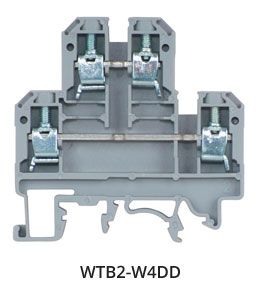
3. Three Level
Level three terminal blocks are the same as dual level products, but with an extra stacked level of contacts. And like dual level terminal blocks, they can be bridged.
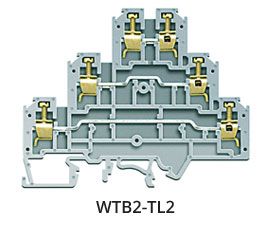
4. High Density Terminal Blocks
High Density Terminal Blocks are designed with the OEM in mind. They are simple to install and the large marking strips can be hand marked or custom printed to provide quick and accurate identification of the terminals.

Terminal Block Features
Some terminal blocks include one or more special features.
Pluggable Terminal Blocks
With pluggable terminal blocks, the wire connections allow the circuit to be broken without the following:
- Enabling quick disconnection
- Unwiring
- Testing
- Maintenance
By combining pluggable terminal blocks in a certain manner, it’s possible to disconnect power to an entire group of terminals at once by simply removing a single plug.
Stackable Terminal Blocks
To save space, stackable terminal blocks can be mounted next to each other. Typically, they are DIN rail mounted devices.
Indicator Light
Some terminal blocks feature an indicator light. This light-emitting diode (LED) verifies that the current is flowing through the device.
Diode
Terminal blocks with diodes between circuits allow for lamp testing. They also provide protection against reverse polarity.
Orientation and Specifications
Terminal blocks commonly come in three different wire entry angles:
- 45°
- 90° (horizontal)
- 180° (vertical)
How the wire is attached to the block is known as contact, position, way or pole. When purchasing terminal blocks, it’s important to know the number of contacts in order to match the number with the number of wires necessary for application.
Contact pitch relates directly to the number of contacts and is expressed in millimeters. It’s the distance between each contact measured from the center of each opening or hole.
Installation Guidelines for a Screw-In Terminal Block
Once you know the exact terminal block type and have purchased it, it’s time to install it. Turn off any electrical equipment prior to installation for safety reasons.
If you have a screw-in terminal block, strip a small amount of insulation from the end of the terminal block wiring. Typically, one inch works fine but may depend on the component being used.
Unscrew the retaining screw from the terminal block. Then insert the wire into the hole.
Take Care to Fully Tighten the Screw
Carefully tighten the screw into place. It’s important to fully tighten the wire because if not, the wire will heat up and melt the insulation. That could cause a fire.
Watch out! Over-tightening screws can crush wires and create bad or even dangerous connections. Ensuring that the screw is tight enough without being over-tightened is important for both safety and performance.
Secure Plug-In Connection
Once you’ve positioned the terminal block, run the electrical wires to it. Then connect the male terminal to the female port.
Next, press firmly to ensure a secure connection that won’t come loose due to movement.
Test Equipment for Safety
After making all the connections to the terminal blocks, it’s time to test the equipment to ensure it’s working correctly. It’s extremely important to test everything to make sure everyone is working in a safe environment.
Don’t forget to check the terminal block as well as the connections to ensure there’s no excessive heat being built up.
Check the wires to make sure they’re still securely in place.
Mounting Terminal Blocks
Most terminal blocks are either screwed into a panel, snapped onto a metal rail or mounted on a printed circuit board.
Rail
Terminal blocks that are mounted are usually done on some form of a DIN rail (Deutsches Institut fur Normung). DIN is the German standards body that originally published rail specifications.
Terminal blocks are manufactured to fit in one of several DIN rail sizes such as:
1. Miniature Top-Hat Rails
Miniature top-hat rails are 15 mm wide. They are rated to 300V.
2. G32 Rails
As their name suggests, these rails are shaped like the letter ‘G’ and are 32 mm wide. They can handle terminal blocks rated to 60V.
3. Top-Hat Rails
Top-hat rails look exactly like their miniature version except they are 35 mm wide. They’re rated to 600V.
4. PCB Mount
There are also terminal blocks which are manufactured for mounting on printed circuit boards. Some products can be plugged into a pin strip which is mounted to the board.
Others have integral pins for mounting through the circuit board. These are also known as electronic blocks.
Method Options to Achieve Wire Connection
There are several different methods to choose from to achieve wire connection using terminal blocks.
Insulation Displacement Connections (IDC)
Insulation displacement connections allow connections to be made by pushing the wire between two sharp pieces of metal. This makes the connection without exposing any bare wire.
IDC terminal blocks were originally developed for use in the telecommunications industry and have an interesting feature; no wire stripping is required. The sharp blades inside the terminal block slice through the insulation to make contact with the wire. Initially more suited to solid wires, today's IDC terminal blocks can be used both with solid and stranded wires.
Screw Clamps
Screw clamps make an electrical connection by using a screw to tighten the wire. They are the industry standard in termination methods.
Screw clamps are able to accommodate wide ranges of wire sizes. They also provide reliable connections.
Spring Clamps
Spring clamps retain wire clamping by using the force of the spring. They’re a new alternative to screw clamps.
Spring clamps are most useful in applications where there are limited working space and small wire diameters to take into consideration. To connect by just pushing in the wire, usually after crimping on a ferrule. The wire is then clamped in place and released by a spring release device, which may, in some cases, require a special tool or small screwdriver depending on the supplier.
Tab Connections
Tab connections are also known as blade or spade terminals. They were designed to be inserted and removed quickly without any need for soldering.
A wire, which is crimped or soldered onto a connector, just slides into the tab on the terminal block of the tab connector. There are other versions that mix a tab connection on one side with a screw clamp on the other. All these give you the assurance of making proper and efficient connections for your wires with your needs and applications.
Applications for Terminal Blocks in Industrial Settings
Terminal blocks are commonly used in industrial equipment such as wired support boxes and control boxes. It’s common to see terminal blocks in the following types of equipment used in industrial settings:
- Blowers
- Control panels
- Electrical substations
- Energy efficient lighting (LED)
- LED municipal outdoor and street lighting
- All Electrical Machinery
- Refrigeration control
- Variable speed/frequency drivers
- Anywhere power is distributed!
Which type of terminal block you require depends on a few factors.
Since there are several types of terminal blocks available, it’s vital to know which one is the right choice before installation.
Current Requirement
The current requirement is the most important thing to consider when choosing which type of terminal block to use. That’s because if too much current is pushed through a terminal block, it can overheat and destroy the terminal block.
Make sure the terminal block can handle the expected use of the current and then add 50% more just to be safe.
Voltage Requirements
Taking the voltage amount into consideration is also important. Otherwise, the voltage can cause problems with dielectric breakdown.
The voltage may be too high for the terminal block and cause current leakage between terminal blocks that are located in close proximity. Be aware that high voltage requirements are rare in design.
Most of the time, voltage considerations are ignored for voltages under 100V. Despite this, it’s still a good idea to check the voltage prior to choosing a terminal block.
Wire Being Used
Wires are not made equally. Each wire type comes with its own set of advantages and disadvantages.
Make sure when choosing a terminal block for a cable to know the size of the cable. It needs to physically fit into the terminal block.
Find out if it’s a single-core or multi-core because multi-core wires work better with screw terminals. Meanwhile, single-core wires work better with push-fit connectors.
Environmental and Mechanical Strength
Consider the environment when choosing a terminal block. Some terminal blocks are made to be mechanically strong. They can handle high currents.
However, if the connection is used in naval environments, the salt air can corrode the metal contacts.
What environment the terminal block is used in can create wide temperate swings and/or contain mechanical vibrations. If that happens, the screw terminations can become unreliable.
Trust Us to Provide You With the Best Products
We pride ourselves on providing above-the-board customer service and high-quality products whether you’re buying terminal blocks, tower lights or anything else you need to run your facility efficiently.
We want to help you find exactly what you’re looking for. Click here to request a catalog.
Disclaimer:
The content provided is intended solely for general information purposes and is provided with the understanding that the authors and publishers are not herein engaged in rendering engineering or other professional advice or services. The practice of engineering is driven by site-specific circumstances unique to each project. Consequently, any use of this information should be done only in consultation with a qualified and licensed professional who can take into account all relevant factors and desired outcomes. The information was posted with reasonable care and attention. However, it is possible that some information is incomplete, incorrect, or inapplicable to particular circumstances or conditions. We do not accept liability for direct or indirect losses resulting from using, relying or acting upon information in this blog post.
OUR PRODUCTS
COMPANY / SERVICES
c3controls Headquarters, USA
664 State Street
Beaver, PA 15009
TEL 724.775.7926
FAX 724.775.5283